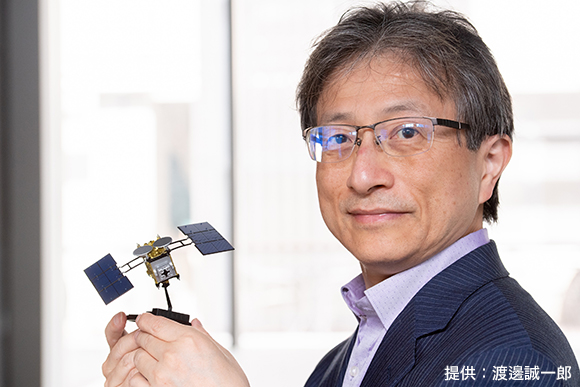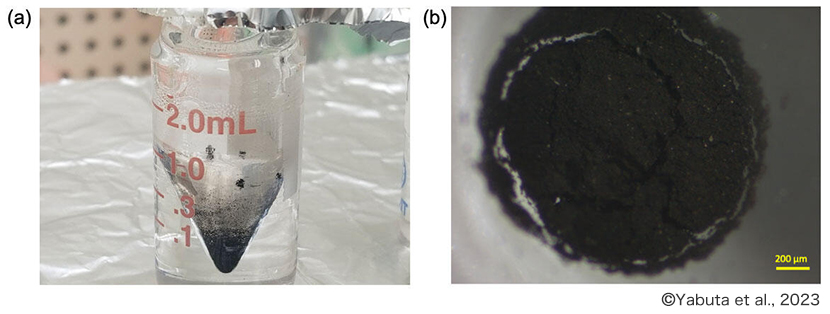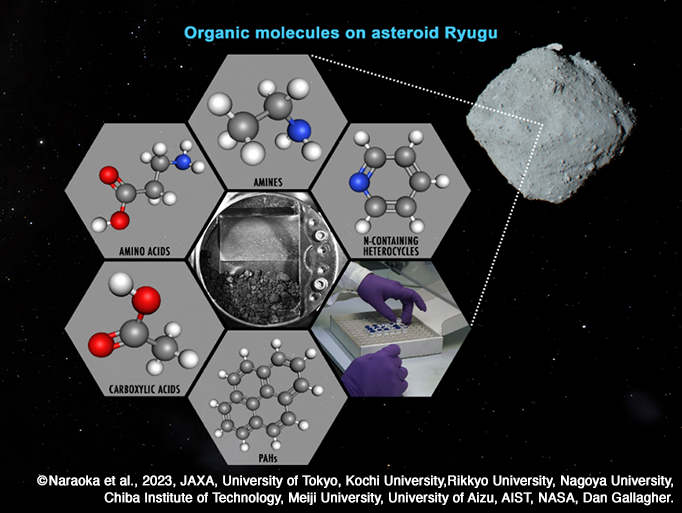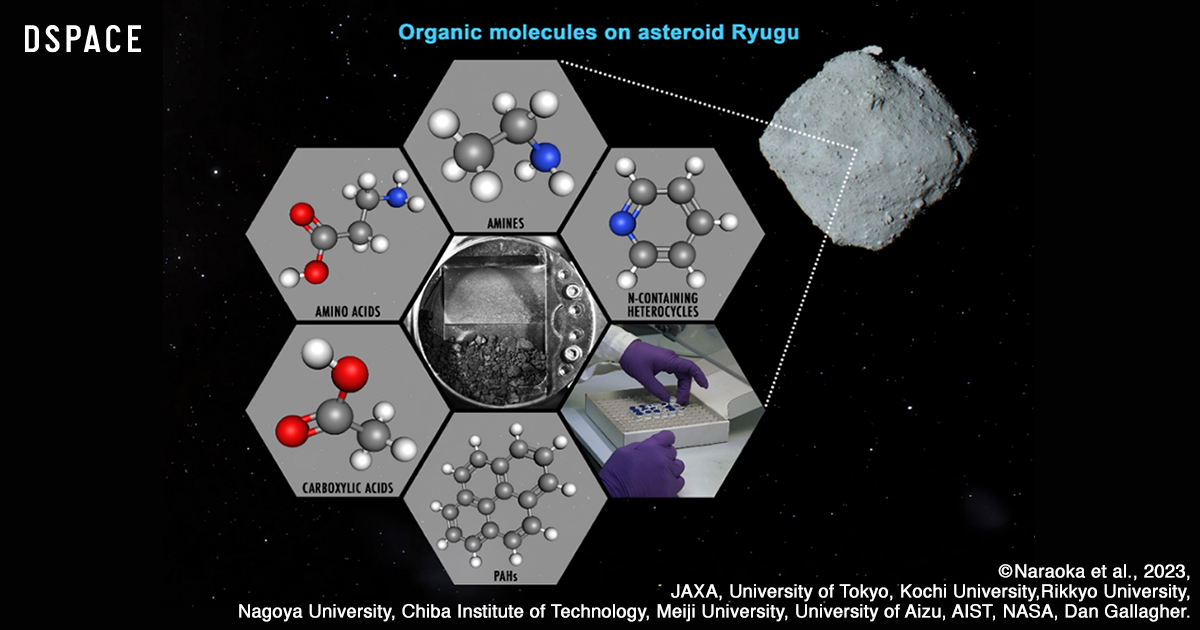Volume 31
What does Ryugu’s organic matter tell us?
Where did the components of life come from?
This is a fundamental question for humanity. This is because thinking about this is nothing but searching for one’s roots.
If you asked the first person to scientifically challenge this question, you would find Soviet chemist Alexander Oparin. In 1923, Oparin first proposed the concept of “chemical evolution”, in which simple organic matter undergoes repeated chemical reactions on the primeval Earth and evolves into organic matter with complex functions. However, there was little physical evidence to support this, and it was rather a working hypothesis focused on fantasy.
The origin of life became a modern experimental science with the advent of Stanley Miller, 30 years after Oparin announced the concept of “chemical evolution”. In 1953, as a graduate student at the University of Chicago, he showed that lightning discharges into the methane-laden atmosphere produce amino acids, the building blocks of life. This is the famous Uri Miller experiment. This experiment was a breakthrough in the sense that it was the first empirical material to prove the “origin of life”.
But the meteorite that fell in 1969 in Australia gave a different idea. The meteorite, named the Murchison meteorite after the nearby village where it fell, was recovered and chemically analyzed shortly after it fell. Fortunately, the most modern analytical equipment and clean rooms of the time were equipped to analyze the Apollo lunar samples. As a result of analysis using these facilities, organic materials such as amino acids have been found in the Murchison meteorite.
Thus, there are two kinds of ideas, one is that the source of materials for life was created on the primordial earth, and the other is that it was brought from outside the earth.
If the former were to dominate, the materials needed for life on Earth would be provided by the planet’s unique environment, and a different life would be born. On the other hand, in the latter case, meteorites containing similar substances will rain down on both Earth and Mars. With this substance, there may be some common elements to life throughout the solar system.
In the year 2023, exactly 100 years after Oparin announced the concept of “chemical evolution”, the results of an analysis of the organic matter of the asteroid Ryugu returned by the Hayabusa2 spacecraft are finally published in the journal Science. This is a long-awaited result.
What does the organic matter in the Ryugu sample tell us?
“My role was to coordinate the international team for the organic matter analysis of the Ryugu samples and set the goals and work procedures for the analysis. I tried to be a team, and after the samples arrived, I distributed the samples to the team and analyzed the chemical composition of the organic matter as one of the active factors. Therefore, during the analysis process, we took great care to Not to be contaminated with ground materials.
Hikaru Yabuta of Hiroshima University, lead author of the Hayabusa2 Organic Solids Analysis Team and lead author of the published paper.
After earning his Ph.D. in Japan, Mr. Yabuta spent four years in the United States, where he was active on the international scene at the forefront of the analysis of extraterrestrial organic matter. At that time, he also participated in the NASA Stardust Expedition, and had the opportunity to analyze cometary dust returned by the spacecraft. In addition to being active on the international stage, Mr. Yabuta himself has a very gentle demeanor. Although he has a core, he also has the ability to listen to what everyone has to say. One of the great fortunes of Hayabusa2, and by extension Japan, is that there is someone with such a proven track record and personality serving as the organics team leader.
What are the new findings from Ryugu samples that were not exposed to Earth’s environment?
In my fourth column, “Hayabusa2 and the “Recipe for Life,” I wrote that Ryugu samples may have some kind of selectivity for organic matter. Life on Earth selects and uses certain compounds, such as 20 types of amino acids and 5 types of nucleic bases. He suggested that selectivity of matter The organic matter on Earth matches the organic matter of Ryugu.
However, the reality was just the opposite. The organic matter in Ryugu’s sample was surprisingly more diverse than the combinations of organic matter found in many of the carbonaceous meteorites we have. There are some organic substances such as amino acids that are used by life on Earth, but they are rather small, and mostly made up of a variety of organic materials not found in life on Earth. Mr Yabuta says:
“In a sample of just 5 grams, the organic matter was surprisingly diverse. Even when viewed at a microscopic scale, different materials appeared dispersed in different places, creating a colorful, colorful world. It is possible that the organic matter of the meteorites detected Its nature has changed due to the influence of the earth’s atmosphere and it has lost its diversity.
How did this diverse ryugu-shaped organic matter form?
In the fourth column, Mr. Seiichiro Watanabe of Nagoya University predicted that ‘organic matter is made by boiling water inside a planet like a pressure cooker. Mr. Watanabe is also one of the co-authors of the paper published by Mr. Yabuta.
“Just as expected, the organic matter was formed by boiling at a pressure of several atmospheres at a low temperature of about 50 degrees Celsius for hundreds of thousands of years in the planet, which is the parent body of Ryugu.”
Mr. Watanabe said proudly, the raw materials for Ryugu’s organic matter are simple molecules that formed in a stage called the molecular cloud long before the formation of the solar system. These original materials were brought into the primordial solar system and are also present in the minor planets. Inside the microplanets, the heat melts the ice, which is then cooked at low temperatures for an extended period with water to form an organic soup.
But if so, why is there such a variety? If you boil them in a pressure cooker, you can naturally make one kind of soup. Watanabe replied,

“There may have been a spatial heterogeneity in the abundance of particles in the raw material. There were more particles in one place, but fewer in another. Also, the amount of water and the amount of minerals acting as catalysts varied from place to place. Events like this must have been have occurred at the microscopic level, creating a variety of organic matter that looks like a jewel box.In some places, the particles are left uncooked, just like the spices in soup are left undissolved, giving Ryugu organics a nutty appearance. .”

Instead of the eclecticism that leads to terrestrial life, Ryugu’s organic matter exhibits a remarkable diversity that exceeds that of terrestrial life. Does this refute the idea that extraterrestrial supplies of materials, such as meteorites, became the ingredients for life on Earth? Yabuta says otherwise.
“What is interesting about this study is that the main components of extraterrestrial organic matter appear to be unrelated to terrestrial life. Once decomposed, they are transformed into organic matter that is unique to their environment. It is found globally in Ryugu throughout the universe, and is provided for by the mantle each celestial body’s unique atmosphere and sea., and turns into organic matter that is unique everywhere, acquiring its own selectivity and function.

Dr. Watanabe, who specializes in the theory of planetary formation, summarized the results of Hayabusa 2 as follows.
“Ryugu’s parent body may have been in the outer region of the primordial solar system, a world rich in ice and organic matter. Small bodies like the original body of Ryugu were scattered countless throughout the solar system, and some supplied planets, including Earth. We were able to show that physical evidence.”
If the amino acids used by life on Earth were found in Ryugu’s samples, it would certainly be an achievement that would be easier for everyone to understand. Not surprisingly, it was featured in the media coverage. However, the presence of amino acids in meteorites was already evident in the Murchison meteorite that fell in 1969, and amino acids are also present in Ryugu samples, but in fact the amount is very small.
On the other hand, the majority of the ubiquitous organic matter on Ryugu appears to have nothing to do with life on Earth, but is probably diverse and versatile types of organic matter that change their appearance according to each planet’s environment. However, there is the difficulty that the essence can only be seen if we move away from the fixed concept of life on Earth. Mr. Yabuta said at the end:
“A lot of people tend to get very comfortable with what they know, like amino acids and nucleic acids, in terms of their outlook on life. I feel like it teaches me the importance of trying to get away sometimes.”
- ※
Company names and trade names mentioned in the text are trademarks or registered trademarks of their respective companies.
- ※
Mitsubishi Electric is responsible for the ground antenna system of the Hayabusa2 project.

“Travel maven. Beer expert. Subtly charming alcohol fan. Internet junkie. Avid bacon scholar.”






More Stories
It's better to call it a digital camera. The Xperia 1 VI lets you take any kind of photo | Gizmodo Japan
Google may be developing a new device called “Google TV Streamer” to replace “Chromecast”
What do you want to talk about? “Persona 3 Reload” recommendation campaign is running until July 31st! |.Persona Channel